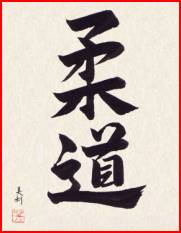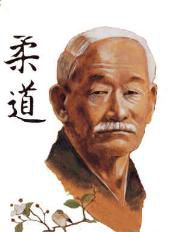JUDOFACTUM
JUDO - more than sport
JIGORO KANO
(1860-1938)
He was a famous educator and the father of modern sports in Japan. But above all, he was the founder of JUDO. He was born in Mikage (now part of Kobe City). His ancestors include many illustrious Shinto priests, Buddhist masters, and Confucian scholars. Japan’s feudal period was rapidly drawing to a close. Across the seas in America, the United States was embarked on a tragic civil war. Just as today, it was a time of turmoil and change around the world. He was fortunate enough to be born into a family that was reasonably well off , at least well enough placed to get Jigoro into the elite Tokyo Imperial University. He declared his majors to be political science, philosophy, and literature. KANO had actually started his training in JU JUTSU at the age of 17. In 1877 he located a good instructor, Hachinosuke FUKUDA (1829-80), of the TENSHIN SHIN YO RYU. In 1879, a year after Jigoro started working out at FUKUDA’s DOJO, the master suddenly died. The 19-year old youth soon joined another branch of the TENSHIN SHIN’YO RYU run by a 62-year old JU JUTSU instructor named Masatomo ISO (1818-81), he was the son of the school’s founder. Over the next two years, KANO practiced JU JUTSU night and day. The SENSEI saw his dedication and promise and soon made him an assistant. Jigoro instructed 20 or 30 students, starting with KATA and then moving on to free fighting. By the time he was 21 years old. KANO had become a master in TENSHIN SHIN’YO-RYU JU JUTSU. But ISO, like FUKUDA before him, became ill and KANO decided to move on. In 1881, when ISO died , KANO was once more left without a teacher. This time KANO met Tsunetoshi IIKUBO, master of the KITO RYU, and began training at his DOJO. In KANO’s time the KITO RYU focused primarly on NAGE-WAZA (throwing techniques). In his memoirs KANO stated, “From Master FUKUDA , I learned what my life’s work would be: from Master Masamoto, I learned the subtle nature of KATA: and from Master IIKUBO, I learned varied techniques and the importance of timing”.
It was during these early JU JUTSU training days KANO worked out some new throws and turned his attention more and more to ways of reforming JU JUTSU into some kind of new system. In 1882 KANO moved to EISHO-JI, a small Jodo Sect Buddhist temple in the Shimo-tani section of Tokyo. There, at the precocious age of twenty-two, he founded the KODOKAN, “Institute for Study of the Way.”
IIKUBO continued to teach KANO during the first half of 1883. Then, one day, KANO grasped the key to JUDO – “If my partner pulls, I push: if he pushes, I pull.” So Jigoro KANO created his own style and ranking system – at this incipient stage, three basic levels (KYU) and three advanced ranks (DAN). Jojiro TOMITA and Shiro SAIGO were the first two trainees to be presented with the rank of SHODAN.
In 1886 KANO moved his residence to Fujumi-cho. Where he built a nice forty-mat facility- nine students registered that year. After he had founded his KODOKAN Institute. His aim was to create a sporting discipline which was much less dangerous, and more likely to meet the wishes of the people in a period of peace. In 1889 KANO left Japan for the first time in his life, for a one-year inspection tour of educational institutions in Europe.
After stopping in Shanghai, he arrived in Marseilles. Over the next year, he visited Paris,
Brussels, Berlin, Vienna, Copenhagen, Stockholm, Amsterdam, the Hague, Rotterdam, and London. He visited the 10th Olympiad in Los Angeles and Vancouver in 1932 and in 1936 he visited Seattle, Vancouver and New York. He gave demonstrations everywhere. In 1906 the Japanese Diet passed a bill requiring all middle school students to be instructed in either KENDO or JUDO. Lot of visitors were becoming a common sight of the KODOKAN. And many KODOKAN students were sent to abroad to teach JUDO (e.g. Y. YAMASHITA, J. TOMITA, M. MAEDA etc.)
In 1909 KANO was selected as the first Japanese member of the INTERNATIONAL OLYMPIC COMMITTEE. While KANO was a member of IOC, and eventually arranged for the 1940 OLYMPICS to be scheduled for Tokyo. He was worried that JUDO in the OLYMPICS would became an instrument of nationalism. (JUDO was not included in the OLYMPICS until 1964.
The last 25 years of KANO’s life were spent in almost constant travel at home and abroad. He made thirteen trips, visiting the four corners of the world. In 1938 KANO attended an OLYMPIC Committee in Cairo, and arranged for the 1940 OLIMPICS to be held in Tokyo. (They were ultimately canceled owing to the outbreak of the World War II). On the return trip to Tokyo aboard the Hikiwamaru, KANO fell ill and died peacefully on May 4, 1938, aged seventy-eight. Today JUDO is one of the largest sport in the world. And it is a part of the physical education systems of many countries.
For READING
1.Kano Jigoro, Nancy H. Ross, “Mind Over Muscle: Writings from the Founder of Judo”, 2006, Kodansha Inc. 160p.
2.Brian N. Watson, “The Father of Judo, a biography of Jigoro Kano”, Kodansha International Ltd., 2000, New York, USA, ISBN 4-77002530-0
3.Kano Jigoro, “Judo (Jujutsu)”, Tokyo, Japan, Buyu Shoseki Shuppan, 2001, 59p, ISBN 4901619005.
4.Kano Jigoro, “Jujutsu and Judo: what are they?”, Tokyo, Japan, Kodokan, 1937, 70p,
5. Stevens, John, “Three budo masters: Jigoro Kano (judo), Gichin Funakoshi (karate), Morihei Ueshiba (Aikido)”, Tokyo, Japan, Kodansha International, 1995, 144p, ISBN 4770018525.
Hírek
- Ch2011-01-07 00:19:34
This past weekend, the International Judo Federation made their first stop on the Grand Slam tour circuit with an event in Paris France.
The French fans packed Bercy with over 10,000 in attendance and were not disappointed when their biggest star was crowned again: Teddy Riner, only 20 years old, won his third consecutive title in the heavyweights at the IJF Paris Grand Slam.
Elco van der Geest (100kg), who now competes under the flag of Belgium after a life long time fighting for Holland. won his first medal in the Paris tournament.
Still in the male divisions, Takashi Ono (JPN) reigned in the 90kg category, his third consecutive Grand Slam win (after Moscow 2009 and Tokyo 2009). In Paris 2009, he won silver.In the 70kg Woman´s division, Lucie Decosse of France continued her stellar career performance. The gold won on the mat in the home country was the sixth for her collection, as she already has the ones from 2001-04-06-08-09.
Out of 226 fights, 132 ended with ippon (58%) in the male divisions, while out of 142 combats, 91 finished by ippon (64%). Seven contests were decided by hansokumake (disqualification) due to leg grabbing. A total of 19 countries (out of 55) won medals.
The full results can be found here. You can watch video here of the +100kg Mens Finals, 100kg Mens Final and -90kg Mens Finals.
The next IJF World Circuit event will be the Grand Prix in Dusseldorf/GER, on the 20-21 February.
Weight Class Final Standings (Men) +100kg 1. RINER, Teddy (FRA)2. VUIJSTERS, Grim (NED)
3. KIM, Sung-Min (KOR)
3. PADAR, Martin (EST)-100kg 1. VAN DER GEEST, Elco (BEL)
2. SAMOYLOVICH, Sergey (RUS)
3. PETERS, Dimitri (GER)
3. TSIREKIDZE, Irakli (GEO)-90kg 1. ONO, Takashi (JPN)
2. CHORIEV, Dilshod (UZB)
3. BENIKHLEF, Amar (ALG)
3. CAMILO, Tiago (BRA)-81kg 1. GUILHEIRO, Leandro (BRA)
2. TSIKLAURI, Levan (GEO)
3. STEVENS, Travis (USA)
3. JEANNIN, Antoine (FRA)-73kg 1. WANG, Ki-Chun (KOR)
2. AKIMOTO, Hiroyuki (JPN)
3. AWANO, Yasuhiro (JPN)
3. IBRAGIMOV, Rinat (KAZ)60kg 1. KIM, Joo-Jin (KOR)
2. SANJAASUREN, Miaragchaa (MGL)
3. HASHBAATAR, Tsagaanbaatar (MGL)
3. LAROSE, David (FRA)-60kg 1. ASUMBANI, David (GEO)
2. SOBIROV, Rishod (UZB)
3. DRAGIN, Dimitri (FRA)
3. FUKUOKA, Masaaki (JPN)


